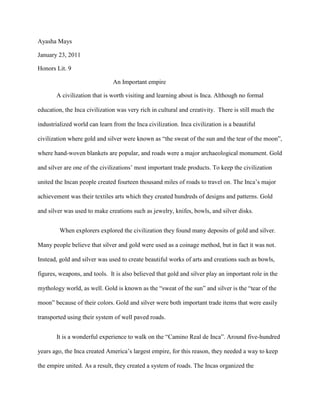
Inca
- 1. Ayasha Mays<br />January 23, 2011<br />Honors Lit. 9<br />An Important empire<br />A civilization that is worth visiting and learning about is Inca. Although no formal education, the Inca civilization was very rich in cultural and creativity. There is still much the industrialized world can learn from the Inca civilization. Inca civilization is a beautiful civilization where gold and silver were known as “the sweat of the sun and the tear of the moon”, where hand-woven blankets are popular, and roads were a major archaeological monument. Gold and silver are one of the civilizations’ most important trade products. To keep the civilization united the Incan people created fourteen thousand miles of roads to travel on. The Inca’s major achievement was their textiles arts which they created hundreds of designs and patterns. Gold and silver was used to make creations such as jewelry, knifes, bowls, and silver disks.<br /> When explorers explored the civilization they found many deposits of gold and silver. Many people believe that silver and gold were used as a coinage method, but in fact it was not. Instead, gold and silver was used to create beautiful works of arts and creations such as bowls, figures, weapons, and tools. It is also believed that gold and silver play an important role in the mythology world, as well. Gold is known as the “sweat of the sun” and silver is the “tear of the moon” because of their colors. Gold and silver were both important trade items that were easily transported using their system of well paved roads.<br />It is a wonderful experience to walk on the “Camino Real de Inca”. Around five-hundred years ago, the Inca created America’s largest empire, for this reason, they needed a way to keep the empire united. As a result, they created a system of roads. The Incas organized the construction of the roads through a system called “La Mita”, an obligation of the population to work a couple of weeks per year in state constructions. The maintenance of the roads was of extreme importance because they needed to be kept in good condition. The first Europeans who traveled in the Andes saw that the roads were superior in quality than those in Rome. Some experts have said that this network of roads created by the Inca Empire is the major archaeological monument in the Americas. The Incan impacted many generations with this invention. This was not their only invention; another famous one is their woven blankets.<br />The last reason for coming to visit the civilization is for its woven blankets. Usually, women were the ones working the thread and machines. Thread was made from llama, alpaca or vicuna’s wool, depending on the article that they were making. Everyday dye was made from plants, fruits, flowers, and leaves, to color the textile, which was later woven into a blanket. They colors that were used were very bright and colorful. The style of weaving that was used to weave the blankets is known as the backstrap loom. Every inch of the blanket was handmade, a reason for its popularity. The blanket is not the only article they wove, but the most popular. <br />It is true that the Incas were not the most technologically and scientifically advanced civilization in that era, but they did accomplish great things. The first roads might not have been that precise as the roads of today, but if it was not for the Incas we would not know what a road looked like or what it was used for. The blankets were not as detailed compared to those produced now, but the textile patterns are still used. The gold and silver articles might not have been that attractive but these figures are still made and are widely known and collected by people all over the world.<br />Their accomplishments as a civilization are many, such as creating an enormous system of roads on which to travel on. Another major achievement was their textiles arts which they created hundreds of designs and patterns. They used their most important trade products, gold and silver, to create details creations. The civilization had a great impact on the world and generations to come .The reason anyone should explore this civilization is because the Inca is one of the greatest civilization ever discovered.<br /> <br />Works Cited<br />Ellie Crystal.Crystalinks.n.p.n.d.web. December 12, 2010.<br />“Peru’s Royal Incantrails.”Angelfire.com. Miguel Chiri Valle. 2009.web.December 12,2010<br />Dr.McGuinness, Tim.Pre-Columbian Gold. McGuinnessPublishing n.d.web.December 12,2010<br />